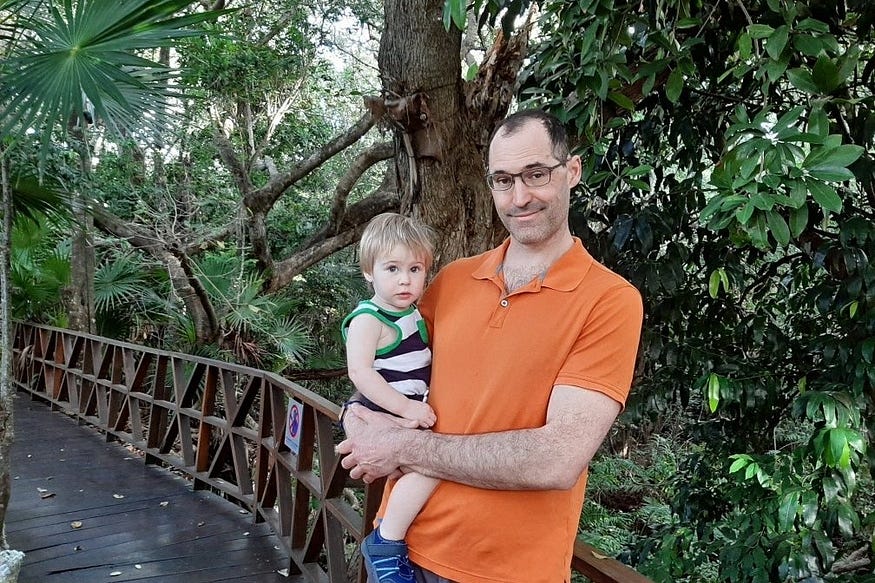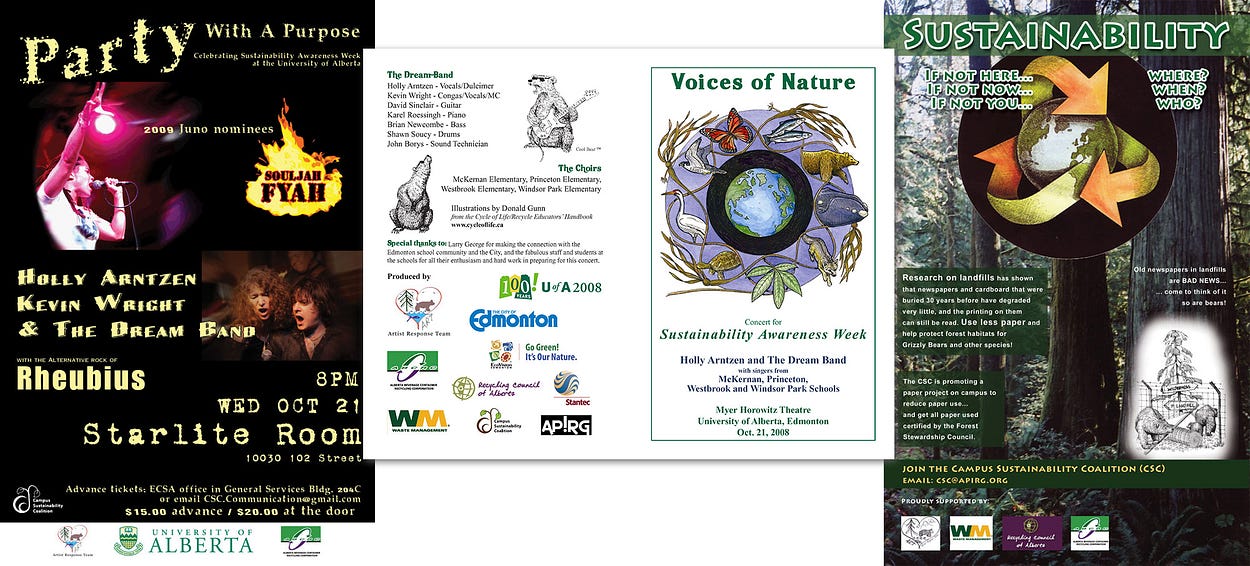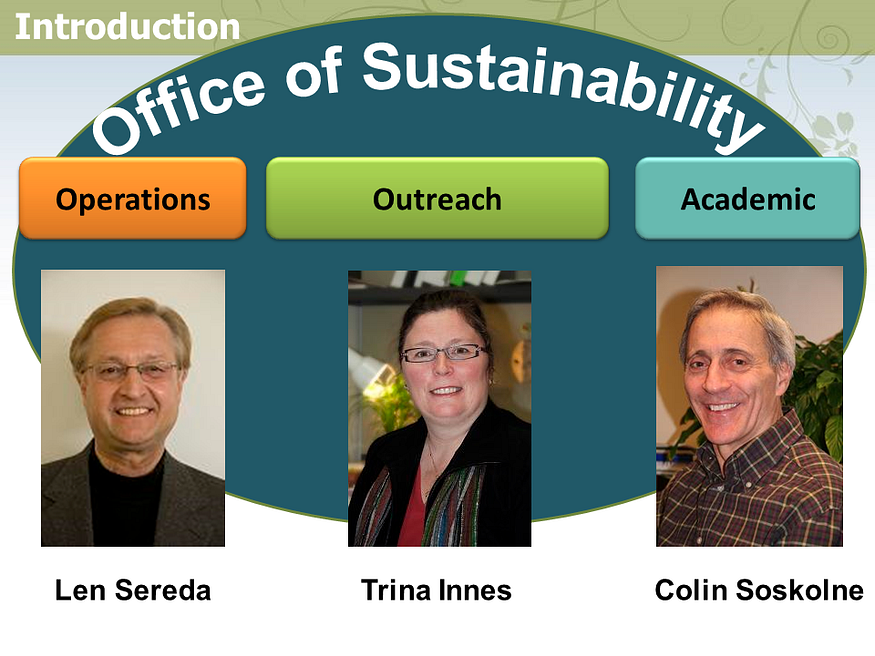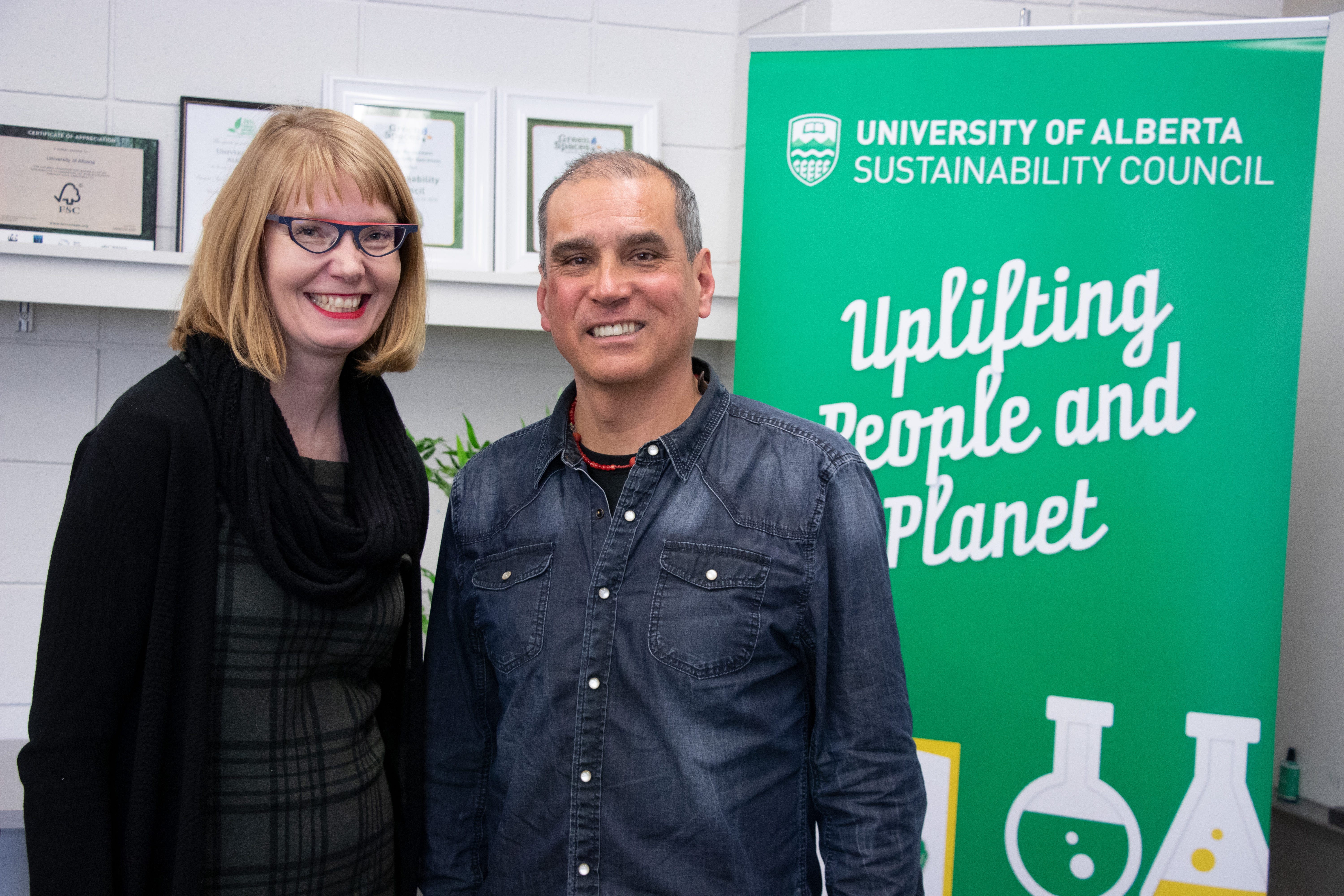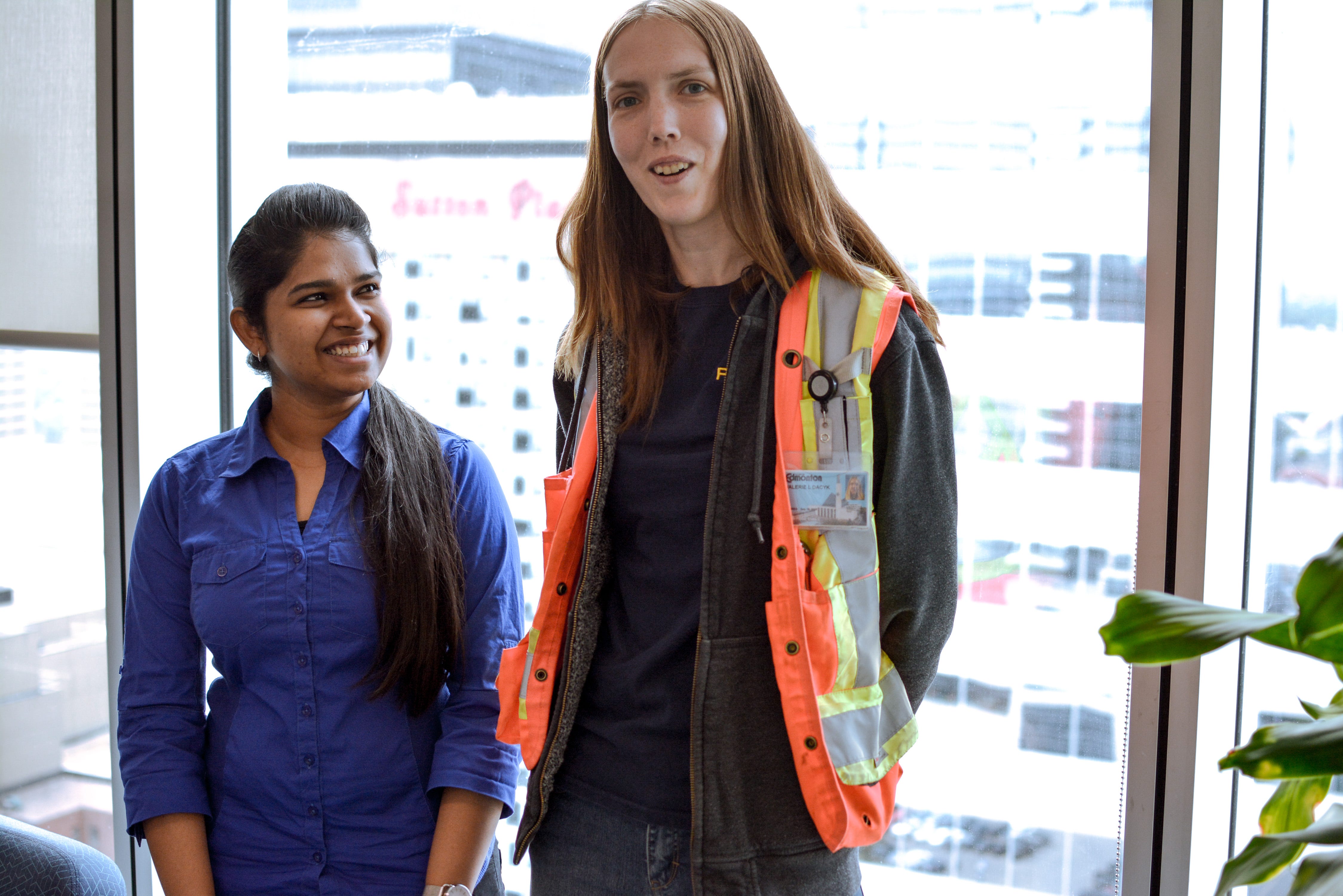How the University of Alberta’s sustainability initiative took flight
In 2007, the dominoes all seemed to line up. Al Gore’s An Inconvenient Truth was winning Oscars and starting conversations at dinner tables around the country. In parliament, politicians were debating a carbon tax while on the streets, thousands were demanding climate action to secure their futures. And the University of Alberta was enjoying a generational reinvestment and expansion. Everything came together for the creation of one of Canada’s largest university sustainability offices.
But even with the right dominoes on the table, it still took some daring people to stick their necks out, push those dominoes into place, and set them into motion. These are their stories.
“It didn’t happen because of organic, spontaneous evolution. It took a lot of persuading, convincing, engagement and inclusion.” — Colin Soskolne.
Michael Rawson Clark addresses the audience at a Sustainability Awareness Week 2008 concert.
A bright light
Michael Rawson Clark always loved being out in nature. In 2004, he left Saskatchewan to study biology at the University of Alberta. He completed his BSc and immediately started a master’s degree in plant ecology. He wanted to know how native prairie grassland might benefit from grazing by native animals such as bison and elk.
“He loved plants, he loved gardening, and he loved the environment,” said Shannon Leblanc, a friend of Clark’s from grad school.
At the U of A, he found all kinds of ways to channel that passion. For instance, in the summer of 2006 he led a naturalization project for the Ecohouse, an experimental residence in Garneau neighborhood for students committed to low-impact living. Clark planted over 70 native plant species in an attempt to return one small plot of land to a native prairie habitat.
While Clark loved spending time with his plants, he was increasingly concerned about the broader state of the natural world. Climate change was all over the news, and he was learning in the classroom how humanity was driving an environmental crisis of huge proportions. And he wanted to fix it.
“He would say, climate change is being recognized all over the world as a crisis and we’re a higher education institution — we should be leading the way. He thought it was really important that the university do that,” said Leblanc.
From his writing, Clark took personal responsibility seriously, and since the university was his community, he truly believed the university had to fix its own environmental footprint first. The university had to “practice what it preaches” if it was going to remain influential.
Posters from the Campus Sustainability Coalition.
The Campus Sustainability Coalition
So with the goal of fixing the University of Alberta, Clark founded the Campus Sustainability Coalition. This APIRG working group was a way to raise awareness and also for Clark to connect with like-minded people. “It was open to anyone, so students, staff, faculty… I think we even got my mom involved. She just liked Michael so much!” said Leblanc.
The coalition organized speaking events, art exhibits, small concerts, resource fairs and community dialogues. They promoted the use of recycled paper and encouraged climate action in residences. Clark claimed the coalition logged 10,000 volunteer hours and brought in over $75,000 in its few short years.
“I think Michael, sort of, intuitively, knew it was all about getting the right people around the table,” said Leblanc.
Most importantly, Clark moved with incredible speed to engage stakeholders across the university. In its first year, he had relationships in place with the Students’ Union, Graduate Students Association, Residence Services, South Campus, Facilities and Operations, Campus Saint-Jean, School of Public Health, School of Business… and that’s just what’s on paper.
“Michael was bright and charming beyond belief,” said Colin Soskolne, professor emeritus and a close supporter of Clark. “He could walk his way into your office and engage you in a way that showed he understood where you were coming from. I think that was his amazing skill, that he could really talk to people and get their buy-in.”
Lisa Dockman was the director of the Students’ Union’s environmental service, ECOS (now Sustain SU). “I remember sitting around a table in GSB with Michael, myself, and several other student groups,” said Dockman. “Michael was energetic, passionate and spoke with conviction. I think he was very good at inspiring the masses.”
While climate change and sustainability were increasingly on the public agenda, this was still a province very much invested in the success of the oil and gas industry. Despite the potential for resistance, Clark quickly made headway putting the issue of sustainability on university administrators’ radar. He even met with President Indira Samarasekera.
“You know, it wasn’t polite conversation to talk about sustainability at that time. Michael was just such a bright, truly magnificent human being, with his goodwill, he simply overcame all of the pushback,” said Soskolne.
Len Sereda is interviewed at the launch of Sustainability Awareness Week 2008.
Green Behind The Scenes
Through Clark’s tireless networking, the Campus Sustainability Coalition’s reputation grew and soon he was put in touch with a crucial figure in the Office of Sustainability’s future: Len Sereda, director of facilities management.
“Len was a powerhouse and an innovator, no question,” said Soskolne.
For most of 2007, Sereda would be quietly formulating a campus-wide sustainability initiative from his desk in the General Services Building. This plan was prompted by a request from the Board of Governors to know more about how the university was prepared for Canadians’ surging interest in climate action.
Under Sereda’s leadership, Facilities & Operations had already begun to take stock of sustainability. But despite their considerable accomplishments, his work showed that the University of Alberta was going to score a dismal grade of C on the forthcoming College Sustainability Report Card, then the foremost benchmark for sustainability in higher education.
“Considering all the things we had done and how proud we were of what we had done, we were quite, quite surprised,” said Sereda. The problem was a lack of an overarching sustainability strategy. “Even though we had a solid foundation, we were missing the key elements like not having a coordinating office and not having a sustainability commitment and not having those elements woven into the university’s strategic plans.”
Sereda set out to draft just such a strategy, developing a vision through consultations within his department and also by reaching out to a small group of academics and students who, through previous inquiries and meetings, he knew were invested in this issue. The timing for the nascent Campus Sustainability Coalition couldn’t have been more perfect — and the same might be said for Sereda.
“Honestly, I think folks like Len Sereda were excited they could take advantage of the fact that there were students like Michael trying to push things forward,” said Leblanc.
Sereda had long been interested in sustainability. He graduated from the Faculty of Engineering in 1972, just in time for a decade of rising oil prices and energy crises. When he was hired in 1986, he was an expert in energy conservation joining an already highly successful energy saving program. He forged ahead with lighting retrofits, HVAC improvements, and conservation measures. After a promotion in 2000, he began to introduce environmental considerations into other departments, greatly expanding the recycling program, requiring green cleaning products, and curbing idling cars.
“It was 100% behind the scenes,” said Leblanc. “He was a constant, pushing it forward within the department. He believed it had an impact and it was the right thing to do.”
So Sereda wasn’t going to wait around for the Grade C report card to drop. He saw the opportunity for the university to save its reputation by raising the profile of sustainability. With climate change high on the public’s mind, the Board of Governors engaged on the issue, and a highly active student knocking on every door he could find, the time was right to call on the university to launch an Office of Sustainability.
Establishing a Shared Vision
In fall 2007, with Vice-President Don Hickey’s support, Facilities and Operations formed a Sustainability Committee. Their first order of business was to move forward the proposal for a university-wide sustainability initiative and an Office of Sustainability. With nearly daily meetings and interviews throughout 2007–08, Sereda led consultations with stakeholders, deans and governance committees.
“I remember every time I met with Len, he just talked about how many times he had to present about this. It was like he was doing a roadshow going from one audience to the next!” said Dockman.
Encouraged, perhaps, by meetings with Clark, the deputy provost took a direct hand helping this small group navigate the consultation and approvals process. She also met several deans herself, shoring up support on the academic side. “Dru Marshall, she was phenomenal,” said Soskolne. “She really knew more than most in terms of making things happen and having the guts to argue and fight for it.”
Progress required a policy statement that could form the institutional basis for the creation of an office, hiring of staff, and investments in new technologies and infrastructure. Finally on June 20, 2008, the Board of Governors considered the issue and gave their endorsement for a University of Alberta Sustainability Commitment and Guiding Principles.
“The University of Alberta is committed to a continuous effort to instill sustainability into the many aspects of university life, on our campuses, in our institutions and in the larger community of which we are part.
“In alignment with its values, vision and mission, the university takes an integrated approach to sustainability that incorporates teaching and learning, research, outreach, and the operations that support them, as it builds one of the great universities for the public good.”
Laying the Foundation
With the board’s commitment, this core group could now move forward with building the Office of Sustainability. From July 2008 to August 2009, Sereda, Soskolne, Marshall and others figured out the staffing, budget and organizational structure.
Slide from a PowerPoint presentation introducing the Office of Sustainability.
Sereda was made director of a new unit, Energy Management and Sustainable Operations (EMSO), that would serve as one pillar of the Office of Sustainability. EMSO hired an Energy Management Program manager to build on Sereda’s foundation in energy efficiency and move boldly into renewable energy generation using photovoltaics. They would also facilitate other departments’ efforts, helping to bring in zero emissions vehicles, organics collection, sustainable dining options, and green building standards.
“My last seven years [prior to retirement] were probably the most enjoyable time that I had at the university, working on sustainability and engaging with so many people across campus,” said Sereda.
The second pillar of the new office would be academic. “Looking at other top institutions it really became obvious that sustainability was just not operations, energy management — really it had to be part of education and outreach and student engagement, and it had to be actually embedded into the academic programs,” said Sereda.
Marshall asked Soskolne to coordinate these efforts, and he brought in many of the diverse faculty members who had already been engaged to serve on the Office of Sustainability Academic Advisory Committee. Included were people like Joseph Doucet (soon to be Dean of Business), one of the “Deans for Green,” Katy Campbell (Dean of Extension), and Frank Robinson (Dean of Students).
“Those were the foundational years, that’s when it was all put together,” said Soskolne.
It is perhaps a reflection of the value that these particular faculty place on teaching that the committee quickly made student learning their priority. Many students come to sustainability with the realization that human problems like poverty are tied to the environment, and environmental problems like climate change are inextricably political and economic. Sustainability education, therefore, requires interdisciplinary thinking. But how could this work in a university with 18 faculties and schools?
Many on the committee hoped to develop a cross-faculty mandatory course to prepare graduates for a world where their careers are shaped and constrained by climate change. Soskolne proposed his interdisciplinary studies class INT D 561 Values, Ethics, and Sustainability, offered by the School of Energy and Environment, as a potential model. Others emphasized the importance of accreditation, such as an interdisciplinary Certificate in Sustainability that could be granted by all faculties.
But funding agencies and the tenure model relies on disciplinary boundaries. Building an academic program that cuts against the grain was difficult work. In this capacity, Soskolne appreciated that Clark was still around.
“He had an appreciation and sensitivity to politics and he used to keep me in line,” said Soskolne, “because I used to get really annoyed coping with the frustrations of pushback from places that you wouldn’t think you would get pushback from.”
Grace Lam, an outreach and engagement intern with the Office of Sustainability in 2014.
Getting the Word Out
To maintain the momentum that would allow something like an interdisciplinary certificate to succeed, the Office of Sustainability required a third pillar, one focused on outreach and engagement.
From the very beginning, Sereda positioned the sustainability initiative as a way to enhance the university’s reputation in a world where prospective students, faculty and donors were increasingly influenced by environmental concerns. It highlights that “while the University’s accomplishments in the area of sustainability are many and varied, they do not appear to be well known nor does sustainability appear to be associated with its institutional image.” The recommendations call for, among other things, high level public relations promotion and broad engagement with the university community.
In its first years, the Office of Sustainability developed a strong publicity team that profiled new and existing sustainability initiatives. Promotions grew through conventional channels — social media, an email newsletter, publications — but also through innovations such as a summertime walking tour, lawn signs, and guerilla street marketing.
Alongside the office’s public education events, these efforts were key to developing a culture of sustainability at the university and a community of engaged participants. In many ways, this arm grew naturally from the Campus Sustainability Coalition’s focus on educational events. The Office of Sustainability would take over Sustainability Awareness Week, growing it from a dozen events to over 60, and launched annual events with the Student Sustainability Summit, Sustainability Speaker Series, and Environment Week.
Lisa Dockman (left) was director of ECOS when Shannon Leblanc was a member of the Campus Sustainability Coalition. They would later work together in the Office of Sustainability and EMSO, respectively.
Dockman, who would join the office shortly after graduation, also saw a connection to her previous organization’s focus on community building. “I think the Office of Sustainability grew to complement ECOS in a really beautiful way,” said Dockman.
“ECOS was a really open place for people to meet one another, work on things they’re passionate about, have good conversations, but also make a difference,” said Dockman. For young people arriving at university and beginning to recognize their values, ECOS was a welcoming space to learn from their peers without judgment.
The Office of Sustainability benefited from and supported this student community. The two organizations jointly ran a volunteer program that in many years had hundreds of student volunteers running events and engaging their peers. The office also gave financial support to the Farmers’ Market, Bike Library and Workshop, the Campus Community Garden, and the Reusable Dish Program.
Finding Direction
All of this happened after September 2009, when the office found its director in Trina Innes, then serving as senior manager of Alberta Environment’s award-winning public education team. As director, and later Chief Sustainability Officer, she would unite facilities, operations, teaching, research and campus life together under the university’s first sustainability plan.
Trina Innes (second from left), Lisa Dockman (second from right) and Shannon Leblanc (right) accept an Emerald Award for the Office of Sustainability.
“My job was to come in and build bridges that brought those areas together, to be the key facilitator and institutional hub for the campus sustainability initiative,” said Innes.
Under her leadership, the Office of Sustainability engaged hundreds of support staff, thousands of students, and many off-campus partners to create a culture of sustainability in residences, student events, laboratories, food and dining, and beyond. The residence engagement program was particularly successful, winning an Alberta Emerald Award and often attracting media attention for Eco Move Out.
Her team applied social marketing and facilitative leadership methods to empower change makers throughout the university. Innes brought the One Simple Act program with her from Alberta Environment, and would develop more tailored programs addressing waste in residence, green offices and green labs. She also worked with Sereda to launch a grant program that captured money from energy savings to be channeled toward student and faculty initiatives.
By 2014, things had improved so much that the University of Alberta was now one of the top ranked universities in Canada, earning the Association for the Advancement of Sustainability in Higher Education’s STARS Gold rating. “Empowering everyone to pull in the same direction and to see the improved performance achieved so quickly, it was very rewarding,” said Innes.
Part of the improvements came from Sereda’s team putting together the first greenhouse gas emissions inventory and reduction plan. And a big part also came from the academic side, which was on solid footing after a few years of organizational shuffle.
Soskolne had been succeeded by Susan Barker as academic coordinator in 2010, but she left in 2012. Naomi Krogman jumped in to serve as academic director from 2012–15, during which time she launched the long-awaited Certificate in Sustainability. This interdisciplinary, embedded certificate gave students the opportunity to complete a 20 hour research project outside of the classroom, an experience that many now consider a highlight of their degrees. Krogman also developed a significant experiential learning component with the Sustainability Scholars graduate student internship, a pilot partnership with the City of Edmonton in 2015.
Academic Sustainability 15 Years Later
Then came a period of years when there was no dedicated lead on academic sustainability. Finally, in 2018 the university gave preference to academic sustainability by giving it the full-time staff and the institutional home it needed to thrive. The Office of Sustainability was closed in order to launch the Sustainability Council, an academic leadership unit that works across faculties to spark learning, discovery and citizenship for sustainability.
“It really was time to build greater collaboration across the academy and to create more meaningful opportunities for students. I am very proud of the university’s sustainability journey,” said Innes.
Now working for the City of Edmonton on energy transition, Dockman agrees about the importance of the new Sustainability Council.
“The focus on academics is really, really important,” said Dockman. “From where I sit now, there’s just such a gap in impactful and appropriate education for the kinds of energy and climate professionals that we need.”
A snapshot of academic sustainability initiatives at the University of Alberta.
As a testament to the university’s invigorated academic sustainability, the Sustainability Council has increased enrolment in the Certificate in Sustainability eight times over from 2018–21. Sustainability Scholars has expanded from six positions to nearly 30 a year. And a bi-weekly academic lecture series drew a cumulative audience of over 1,500 this year.
For Soskolne, the Sustainability Council’s success can be traced back to Clark. “What I can tell you is that without Michael, I think it would be fair to say that the Office of Sustainability’s academic arm might not exist today. I mean, that’s how important I believe he was to its formation,” said Soskolne.
If you’ve read this far, then it’s clear that the story of how the Office of Sustainability came to be is not the story of one person. Accomplished and senior staff like Sereda and Innes mobilized people and resources; powerful deans and faculty gave it their energy and intellectual capital; students from all ideologies and persuasions pressed for change.
But from Soskolne’s position, the fact that so many diverse people came together in pursuit of a common goal — that is itself testament to Clark’s special contribution.
“I don’t think it would have happened if Michael hadn’t been able to connect these people, to bring them together. Whoever he spoke to found a compelling, cogently argued vision for what was needed. And his vision was gelled in bringing together their expertise and participation,” said Soskolne.
“He was so charming,” said Soskolne. “He was so energetic, so well meaning, he had the youth, you know, he was just — he was wonderful!”
Today we are at another crucial juncture. A movement that began in Rio and reached a peak with Al Gore’s Oscar-winning slideshow has hit new heights with Greta Thunberg. Today, the University of Alberta is showing that it aims to become a world leader in advancing the Sustainable Development Goals.
15 years after Michael Rawson Clark founded the Campus Sustainability Coalition, the Sustainability Council will realize one of his aspirations by launching a suite of SUST courses, providing every student the opportunity to learn about sustainability.
The dominoes have not stopped falling.
In Memoriam: The Sustainability Council honours Michael Rawson Clark who passed away on April 27, 2020 at the age of 39. He will be forever missed by his wife, Dawn MacRitchie, and son Lauchlin, now two years old.
